The Role of Magma Mixing in Generating Granodioritic Intrusions Related to Cu–W Mineralization: A Case Study from Qiaomaishan Deposit, Eastern China
Abstract
:1. Introduction
2. Geological Setting
2.1. Regional Geology
2.2. Geology of Deposits
3. Methods and Sample Descriptions
4. Results
4.1. Whole-Rock Geochemistry
4.2. Mineral Chemistry and Isotopic Studies
4.3. Sr–Nd–Pb Isotopes
5. Discussion and Conclusions
5.1. Magma Origin
5.2. Source Characteristics
5.3. Source of Cu and W
5.4. Ore-Forming Process
Supplementary Materials
Author Contributions
Funding
Acknowledgments
Conflicts of Interest
Appendix A. Analytical Methods
Appendix A.1. Zircon LA-ICM-MS U–Pb Dating
Appendix A.2. In-Situ Zircon Lu–Hf Isotopes
Appendix A.3. Microprobe Analyses
Appendix A.4. Major and Trace Elements
Appendix A.5. Whole-Rock Sr–Nd–Pb Isotopes
References
- Chang, Y.; Liu, X.; Wu, Y.-C. The Copper-Iron Belt of the Lower and Middle Reaches of the Changjiang River; Geological Publishing House: Beijing, China, 1991; pp. 1–56. [Google Scholar]
- Pan, Y.; Dong, P. The Lower Changjiang (Yangzi/Yangtze river) metallogenic belt, east central China: Intrusion-and wall rock-hosted Cu-Fe-Au, Mo, Zn, Pb, Ag deposits. Ore Geol. Rev. 1999, 15, 177–242. [Google Scholar] [CrossRef]
- Mao, J.; Xie, G.; Duan, C.; Pirajno, F.; Ishiyama, D.; Chen, Y. A tectono-genetic model for porphyry-skarn-stratabound Cu-Au-Mo-Fe and magnetite-apatite deposits along the Middle-Lower Yangtze River Valley, Eastern China. Ore Geol. Rev. 2011, 43, 294–314. [Google Scholar] [CrossRef]
- Yang, X.-Y.; Lee, I. Review of the stable isotope geochemistry of Mesozoic igneous rocks and Cu-Au deposits along the middle-lower Yangtze metallogenic belt, China. Int. Geol. Rev. 2011, 53, 741–757. [Google Scholar] [CrossRef]
- Zhou, T.; Wang, S.; Fan, Y.; Yuan, F.; Zhang, D.; White, N.C. A review of the intracontinental porphyry deposits in the Middle-Lower Yangtze River Valley metallogenic belt, Eastern China. Ore Geol. Rev. 2015, 65, 433–456. [Google Scholar] [CrossRef]
- Qi, H.; Lu, S.; Yang, X.; Zhou, Y.; Zhao, L.; Deng, J.; Li, J. Formation of the granodiorite-hosting Magushan Cu-Mo polymetallic deposit in Southern Anhui, Eastern China: Evidence from geochronology and geochemistry. Minerals 2019, 9, 475. [Google Scholar] [CrossRef] [Green Version]
- Xiao, Q.-L.; Zhou, T.-F.; Wang, S.-W.; Yuan, F.; White, N.C.; Wang, F.-Y.; Xie, Z.-J.; Liu, J. Genesis of chating Cu-Au deposit in the Middle-Lower Yangtze River metallogenic belt, Eastern China: Implications from magnetite and biotite geochemistry. Ore Geol. Rev. 2019, 106, 113–133. [Google Scholar] [CrossRef]
- Liu, X.; Duan, L. Geological features and metallogenic regularity of the Tongshan-Qiaomaishan Cu-S-W-Fe polymetallic ore deposit in Xuancheng City. Geol. Anhui 2015, 25, 174–178. (In Chinese) [Google Scholar]
- Deng, J.; Yang, X.; Li, S.; Gu, H.; Mastoi, A.S.; Sun, W. Partial melting of subducted paleo-Pacific plate during the early Cretaceous: Constraint from adakitic rocks in the Shaxi porphyry Cu-Au deposit, Lower Yangtze River Belt. Lithos 2016, 262, 651–667. [Google Scholar] [CrossRef]
- Pan, X.; Hou, Z.; Li, Y.; Chen, G.; Zhao, M.; Zhang, T.; Zhang, C.; Wei, J.; Kang, C. Dating the giant Zhuxi W-Cu deposit (Taqian-Fuchun Ore Belt) in South China using molybdenite Re-Os and muscovite Ar-Ar system. Ore Geol. Rev. 2017, 86, 719–733. [Google Scholar] [CrossRef]
- Sun, K.; Chen, B.; Deng, J. Ore genesis of the Zhuxi supergiant W-Cu skarn polymetallic deposit, South China: Evidence from scheelite geochemistry. Ore Geol. Rev. 2019, 107, 14–29. [Google Scholar] [CrossRef]
- Mao, Z.-H.; Liu, J.-J.; Mao, J.-W.; Deng, J.; Zhang, F.; Meng, X.-Y.; Xiong, B.-K.; Xiang, X.-K.; Luo, X.-H. Geochronology and geochemistry of granitoids related to the giant Dahutang tungsten deposit, middle Yangtze River region, China: Implications for petrogenesis, geodynamic setting, and mineralization. Gondwana Res. 2015, 28, 816–836. [Google Scholar] [CrossRef]
- Hong, D.; Huang, Z.; Chan, S.; Wang, X. Geological characteristics and exploration directions of the Cu-polymetallic ore deposits in the Magushan-Qiaomaishan areas in Xuancheng, Anhui Province. East. Chin. Geol. 2016, 38, 28–36. (In Chinese) [Google Scholar]
- Mao, J.; Duan, C.; Liu, J.; Zhang, C. Metallogeny and corresponding mineral deposit model of the Cretaceous terrestrial volcanic-intrusive rocks-related polymetallic iron deposits in Middle-Lower Yangtze River Valley. Acta Petrol. Sin. 2012, 28, 1–14. (In Chinese) [Google Scholar]
- Xue, H.; Ma, F.; Song, X. Geochronology and geochemistry of the Neoproterozoic granitoid association from eastern segment of the Jiangnan Orogen, China: Constraints on the timing and process of amalgamation between the Yangtze and Cathaysia blocks. Acta Petrol. Sin. 2010, 26, 3215–3244. (In Chinese) [Google Scholar]
- Xie, J.; Yang, X.; Sun, W.; Du, J. Early Cretaceous dioritic rocks in the Tongling region, eastern China: Implications for the tectonic settings. Lithos 2012, 150, 49–61. [Google Scholar] [CrossRef]
- Sun, W.; Ling, M.; Yang, X.; Fan, W.; Ding, X.; Liang, H. Ridge subduction and porphyry copper-gold mineralization: An overview. Sci. China Earth Sci. 2010, 53, 475–484. [Google Scholar] [CrossRef]
- Deng, J.; Yang, X.; Sun, W.; Huang, Y.; Chi, Y.; Yu, L.; Zhang, Q. Petrology, geochemistry, and tectonic significance of Mesozoic shoshonitic volcanic rocks, Luzong volcanic basin, eastern China. Int. Geol. Rev. 2012, 54, 714–736. [Google Scholar] [CrossRef]
- Mao, J.; Wang, Y.; Lehmann, B.; Yu, J.; Du, A.; Mei, Y.; Li, Y.; Zang, W.; Stein, H.J.; Zhou, T. Molybdenite Re-Os and albite 40Ar/39Ar dating of Cu-Au-Mo and magnetite porphyry systems in the Yangtze River valley and metallogenic implications. Ore Geol. Rev. 2006, 29, 307–324. [Google Scholar] [CrossRef]
- Zhou, T.; Fan, Y.; Yuan, F.; Zhang, L.; Qian, B.; Ma, L.; Yang, X.; Cooke, D.R. Geochronology and significance of volcanic rocks in the Ning-Wu Basin of China. Sci. China Earth Sci. 2011, 54, 185–196. [Google Scholar] [CrossRef]
- Gu, H.; Yang, X.; Deng, J.; Duan, L.; Liu, L. Geochemical and zircon U-Pb geochronological study of the Yangshan A-type granite: Insights into the geological evolution in south Anhui, eastern Jiangnan Orogen. Lithos 2017, 284, 156–170. [Google Scholar] [CrossRef]
- Li, H.; Ling, M.-X.; Li, C.-Y.; Zhang, H.; Ding, X.; Yang, X.-Y.; Fan, W.-M.; Li, Y.-L.; Sun, W.-D. A-Type granite belts of two chemical subgroups in central eastern China: Indication of ridge subduction. Lithos 2012, 150, 26–36. [Google Scholar] [CrossRef]
- Zhao, Z.-F.; Zheng, Y.-F.; Wei, C.-S.; Gong, B. Temporal relationship between granite cooling and hydrothermal uranium mineralization at Dalongshan in China: A combined radiometric and oxygen isotopic study. Ore Geol. Rev. 2004, 25, 221–236. [Google Scholar] [CrossRef]
- Jiang, F.; Xu, X.; Qian, S.; Wang, M.; Yang, Q.; Li, K. Zircon U-Pb age and genesis of the ore-bearing quartz-dioritic porphyries in the chating Cu-Au ore deposit, Xuancheng City, Anhui Province. Geol. J. China Univ. 2017, 23, 591–605. (In Chinese) [Google Scholar]
- Tang, Y.; Wu, F.; Chu, G.; Xing, F.; Wang, Y.; Gao, Y.; Chang, Y. Geology of Copper-Gold Polymetallic Deposits in the Along-Changjiang Area of Anhui Province; Geological Publishing House: Beijing, China, 1998; pp. 1–351. [Google Scholar]
- Huang, R.; Cao, J. Analysis and study on Maoshan nappe tectonic zone in Jiangsu. J. Geol. 2010, 34, 6–9. (In Chinese) [Google Scholar]
- Middlemost, E.A. Naming materials in the magma/igneous rock system. Earth Sci. Rev. 1994, 37, 215–224. [Google Scholar] [CrossRef]
- Peccerillo, A.; Taylor, S. Geochemistry of Eocene calc-alkaline volcanic rocks from the Kastamonu area, northern Turkey. Contrib. Mineral. Petrol. 1976, 58, 63–81. [Google Scholar] [CrossRef]
- Irvine, T.; Baragar, W. A guide to the chemical classification of the common volcanic rocks. Can. J. Earth Sci. 1971, 8, 523–548. [Google Scholar] [CrossRef]
- Chen, C.J.; Chen, B.; Li, Z.; Wang, Z.Q. Important role of magma mixing in generating the Mesozoic monzodioritic-granodioritic intrusions related to Cu mineralization, Tongling, East China: Evidence from petrological and in situ Sr-Hf isotopic data. Lithos 2016, 248, 80–93. [Google Scholar] [CrossRef]
- Defant, M.J.; Drummond, M.S. Derivation of some modern arc magmas by melting of young subducted lithosphere. Nature 1990, 347, 662–665. [Google Scholar] [CrossRef]
- Liu, S.-A.; Li, S.; He, Y.; Huang, F. Geochemical contrasts between early Cretaceous ore-bearing and ore-barren high-Mg adakites in central-eastern China: Implications for petrogenesis and Cu-Au mineralization. Geochim. Cosmochim. Acta 2010, 74, 7160–7178. [Google Scholar] [CrossRef]
- Qian, Q.; Hermann, J. Partial melting of lower crust at 10–15 kbar: Constraints on adakite and TTG formation. Contrib. Mineral. Petrol. 2013, 165, 1195–1224. [Google Scholar] [CrossRef]
- Wang, Q.; Wyman, D.A.; Xu, J.-F.; Zhao, Z.-H.; Jian, P.; Xiong, X.-L.; Bao, Z.-W.; Li, C.-F.; Bai, Z.-H. Petrogenesis of Cretaceous adakitic and shoshonitic igneous rocks in the Luzong area, Anhui Province (eastern China): Implications for geodynamics and Cu-Au mineralization. Lithos 2006, 89, 424–446. [Google Scholar] [CrossRef]
- Wang, Q.; Wyman, D.A.; Xu, J.; Jian, P.; Zhao, Z.; Li, C.; Xu, W.; Ma, J.; He, B. Early Cretaceous adakitic granites in the Northern Dabie Complex, central China: Implications for partial melting and delamination of thickened lower crust. Geochim. Cosmochim. Acta 2007, 71, 2609–2636. [Google Scholar] [CrossRef]
- Zhao, J.; Zhou, M. Neoproterozoic adakitic plutons in the northern margin of the Yangtze Block, China: Partial melting of a thickened lower crust and implications for secular crustal evolution. Lithos 2008, 104, 231–248. [Google Scholar] [CrossRef]
- Yan, J.; Chen, J.-F.; Xu, X.-S. Geochemistry of Cretaceous mafic rocks from the Lower Yangtze region, eastern China: Characteristics and evolution of the lithospheric mantle. J. Asian Earth Sci. 2008, 33, 177–193. [Google Scholar] [CrossRef]
- Sun, S.-S.; McDonough, W.-S. Chemical and isotopic systematics of oceanic basalts: Implications for mantle composition and processes. Geol. Soc. Lond. Spec. Publ. 1989, 42, 313–345. [Google Scholar] [CrossRef]
- Watson, E.; Wark, D.; Thomas, J. Crystallization thermometers for zircon and rutile. Contrib. Mineral. Petrol. 2006, 151, 413–433. [Google Scholar] [CrossRef]
- Ballard, J.R.; Palin, M.J.; Campbell, I.H. Relative oxidation states of magmas inferred from Ce (IV)/Ce (III) in zircon: Application to porphyry copper deposits of northern Chile. Contrib. Mineral. Petrol. 2002, 144, 347–364. [Google Scholar] [CrossRef]
- Liang, H.-Y.; Campbell, I.H.; Allen, C.; Sun, W.-D.; Liu, C.-Q.; Yu, H.-X.; Xie, Y.-W.; Zhang, Y.-Q. Zircon Ce4+/Ce3+ ratios and ages for Yulong ore-bearing porphyries in eastern Tibet. Miner. Depos. 2006, 41, 152–159. [Google Scholar] [CrossRef]
- Guo, J.-L.; Gao, S.; Wu, Y.-B.; Li, M.; Chen, K.; Hu, Z.-C.; Liang, Z.-W.; Liu, Y.-S.; Zhou, L.; Zong, K.-Q. 3.45 Ga granitic gneisses from the Yangtze Craton, South China: Implications for Early Archean crustal growth. Precambrian Res. 2014, 242, 82–95. [Google Scholar] [CrossRef]
- Hu, J.; Liu, X.; Chen, L.; Qu, W.; Li, H.; Geng, J. A ~2.5 Ga magmatic event at the northern margin of the Yangtze craton: Evidence from U-Pb dating and Hf isotope analysis of zircons from the Douling Complex in the South Qinling orogen. Chin. Sci. Bull. 2013, 58, 3564–3579. [Google Scholar] [CrossRef] [Green Version]
- Mao, Z.; Cheng, Y.; Liu, J.; Yuan, S.; Wu, S.; Xiang, X.; Luo, X. Geology and molybdenite Re-Os age of the Dahutang granite-related veinlets-disseminated tungsten ore field in the Jiangxin Province, China. Ore Geol. Rev. 2013, 53, 422–433. [Google Scholar] [CrossRef]
- Hofmann, A. Sampling mantle heterogeneity through oceanic basalts: Isotopes and trace elements. Treatise Geochem. 2003, 2, 61–101. [Google Scholar]
- Chen, D.; Zhi, X.; Li, B.; Wang, Y.; Yang, J. The Nd, Sr and Pb isotopic characteristics of lherzolite xenoliths from Panshishan, Jiangsu Province. Geochimica 1994, 3, 245–253. (In Chinese) [Google Scholar]
- Gao, S.; Ling, W.; Qiu, Y.; Lian, Z.; Hartmann, G.; Simon, K. Contrasting geochemical and Sm-Nd isotopic compositions of Archean metasediments from the Kongling high-grade terrain of the Yangtze craton: Evidence for cratonic evolution and redistribution of REE during crustal anatexis. Geochim. Cosmochim. Acta 1999, 63, 2071–2088. [Google Scholar] [CrossRef]
- Jahn, B.; Wu, F.; Lo, C.-H.; Tsai, C.-H. Crust-Mantle interaction induced by deep subduction of the continental crust: Geochemical and Sr-Nd isotopic evidence from post-collisional mafic-ultramafic intrusions of the northern Dabie complex, central China. Chem. Geol. 1999, 157, 119–146. [Google Scholar] [CrossRef]
- Tang, C.; Yang, X.; Cao, J. Genesis of the Shangjinshan W-Mo polymetallic deposit in the Eastern Jiangnan tungsten belt: Evidence from geochemistry, geochronology and zircon Hf isotope analyses. Ore Geol. Rev. 2019, 115, 103172. [Google Scholar] [CrossRef]
- Ling, M.-X.; Wang, F.-Y.; Ding, X.; Hu, Y.-H.; Zhou, J.-B.; Zartman, R.E.; Yang, X.-Y.; Sun, W. Cretaceous ridge subduction along the lower Yangtze River belt, eastern China. Econ. Geol. 2009, 104, 303–321. [Google Scholar] [CrossRef] [Green Version]
- Xu, J.-F.; Shinjo, R.; Defant, M.J.; Wang, Q.; Rapp, R.P. Origin of Mesozoic adakitic intrusive rocks in the Ningzhen area of east China: Partial melting of delaminated lower continental crust? Geology 2002, 30, 1111–1114. [Google Scholar] [CrossRef]
- Li, J.-W.; Zhao, X.-F.; Zhou, M.-F.; Ma, C.-Q.; de Souza, Z.S.; Vasconcelos, P. Late Mesozoic magmatism from the Daye region, eastern China: U-Pb ages, petrogenesis, and geodynamic implications. Contrib. Mineral. Petrol. 2009, 157, 383–409. [Google Scholar] [CrossRef]
- Li, X.-H.; Li, Z.-X.; Li, W.-X.; Wang, X.-C.; Gao, Y. Revisiting the “C-type adakites” of the Lower Yangtze River Belt, central eastern China: In situ zircon Hf-O isotope and geochemical constraints. Chem. Geol. 2013, 345, 1–15. [Google Scholar] [CrossRef] [Green Version]
- Xie, G.; Mao, J.; Xiongwei, L.; Duan, C.; Yao, L. Late Mesozoic bimodal volcanic rocks in the Jinniu basin, Middle-Lower Yangtze River Belt (YRB), East China: Age, petrogenesis and tectonic implications. Lithos 2011, 127, 144–164. [Google Scholar] [CrossRef]
- Di, Y.; Zhao, H.; Zhang, Y.; Zhao, J.; Yang, L. Petrographic evidence for magma mixing in the granitoids from Tongling area, Anhui Province. Beijing Geol. 2003, 15, 12–17. (In Chinese) [Google Scholar]
- Guo, W.; Lu, J.; Jiang, S.; Zhang, R.; Zhao, Z. Chronology, Hf isotopes, geochemistry, and petrogenesis of the magmatic rocks in the Shizishan ore field of Tongling, Anhui Province. Sci. China Earth Sci. 2013, 56, 993–1013. [Google Scholar] [CrossRef]
- Wang, F.; Liu, S.-A.; Li, S.; Akhtar, S.; He, Y. Zircon U-Pb ages, Hf-O isotopes and trace elements of Mesozoic high Sr/Y porphyries from Ningzhen, eastern China: Constraints on their petrogenesis, tectonic implications and Cu mineralization. Lithos 2014, 200, 299–316. [Google Scholar] [CrossRef]
- Wang, S.; Zhou, T.; Yuan, F.; Fan, Y.; Cooke, D.R.; Zhang, L.; Fu, B.; White, N.C. Geochemical characteristics of the Shujiadian Cu deposit related intrusion in Tongling: Petrogenesis and implications for the formation of porphyry Cu systems in the Middle-Lower Yangtze River Valley metallogenic belt, eastern China. Lithos 2016, 252, 185–199. [Google Scholar] [CrossRef]
- Rapp, R.P.; Watson, E.B. Dehydration melting of metabasalt at 8–32 kbar: Implications for continental growth and crust-mantle recycling. J. Petrol. 1995, 36, 891–931. [Google Scholar] [CrossRef]
- Chen, B.; Chen, Z.; Jahn, B. Origin of mafic enclaves from the Taihang Mesozoic orogen, north China craton. Lithos 2009, 110, 343–358. [Google Scholar] [CrossRef]
- Ma, Q.; Zheng, J.-P.; Xu, Y.-G.; Griffin, W.L.; Zhang, R.-S. Are continental “adakites” derived from thickened or foundered lower crust? Earth Planet. Sci. Lett. 2015, 419, 125–133. [Google Scholar] [CrossRef]
- Richards, J.P.; Kerrich, R. Special paper: Adakite-Like rocks: Their diverse origins and questionable role in metallogenesis. Econ. Geol. 2007, 102, 537–576. [Google Scholar] [CrossRef]
- Xie, J.; Wang, Y.; Li, Q.; Yan, J.; Sun, W. Petrogenesis and metallogenic implications of Late Mesozoic intrusive rocks in the Tongling region, eastern China: A case study and perspective review. Int. Geol. Rev. 2018, 60, 1361–1380. [Google Scholar] [CrossRef]
- Holwell, D.A.; Fiorentini, M.; McDonald, I.; Lu, Y.; Giuliani, A.; Smith, D.J.; Keith, M.; Locmelis, M. A metasomatized lithospheric mantle control on the metallogenic signature of post-subduction magmatism. Nat. Commun. 2019, 10, 1–10. [Google Scholar] [CrossRef] [PubMed] [Green Version]
- Sun, W.; Ding, X.; Ling, M.-X.; Zartman, R.E.; Yang, X.-Y. Subduction and ore deposits. Int. Geol. Rev. 2015, 57, 3–6. [Google Scholar] [CrossRef]
- Mungall, J.E. Roasting the mantle: Slab melting and the genesis of major Au and Au-rich Cu deposits. Geology 2002, 30, 915–918. [Google Scholar] [CrossRef]
- Sun, W.; Arculus, R.J.; Kamenetsky, V.S.; Binns, R.A. Release of gold-bearing fluids in convergent margin magmas prompted by magnetite crystallization. Nature 2004, 431, 975–978. [Google Scholar] [CrossRef]
- Sillitoe, R.H. Porphyry copper systems. Econ. Geol. 2010, 105, 3–41. [Google Scholar] [CrossRef] [Green Version]
- Richards, J.P. Tectonic, magmatic, and metallogenic evolution of the Tethyan orogen: From subduction to collision. Ore Geol. Rev. 2015, 70, 323–345. [Google Scholar] [CrossRef]
- Lu, Q.-T.; Hou, Z.-Q.; Yang, Z.-S.; Shi, D. Underplating in the middle-lower Yangtze Valley and model of geodynamic evolution: Constraints from geophysical data. Sci. China Ser. D Earth Sci. 2005, 48, 985–999. [Google Scholar] [CrossRef]
- Chen, J.-F.; Yan, J.; Xie, Z.; Xu, X.; Xing, F. Nd and Sr isotopic compositions of igneous rocks from the Lower Yangtze region in eastern China: Constraints on sources. Phys. Chem. Earth Part A 2001, 26, 719–731. [Google Scholar] [CrossRef]
- Xing, F.; Xu, X.; Li, C. Discovery of the Early Proterozoic basement in the Middle-Lower Reaches of Yangtze River and its significance. Chin. Sci. Bull. 1994, 39, 136–139. (In Chinese) [Google Scholar]
- Song, G.; Qin, K.; Li, G.; Evans, N.J.; Li, X. Mesozoic magmatism and metallogeny in the Chizhou area, Middle-Lower Yangtze Valley, SE China: Constrained by petrochemistry, geochemistry and geochronology. J. Asian Earth Sci. 2014, 91, 137–153. [Google Scholar] [CrossRef]
- Sun, W.; Zhang, H.; Ling, M.-X.; Ding, X.; Chung, S.-L.; Zhou, J.; Yang, X.-Y.; Fan, W. The genetic association of adakites and Cu-Au ore deposits. Int. Geol. Rev. 2011, 53, 691–703. [Google Scholar] [CrossRef]
- Sun, W.-D.; Liang, H.-Y.; Ling, M.-X.; Zhan, M.-Z.; Ding, X.; Zhang, H.; Yang, X.-Y.; Li, Y.-L.; Ireland, T.R.; Wei, Q.-R. The link between reduced porphyry copper deposits and oxidized magmas. Geochim. Cosmochim. Acta 2013, 103, 263–275. [Google Scholar] [CrossRef]
- Lee, C.-T.A.; Luffi, P.; Chin, E.J.; Bouchet, R.; Dasgupta, R.; Morton, D.M.; Le Roux, V.; Yin, Q.-Z.; Jin, D. Copper systematics in arc magmas and implications for crust-mantle differentiation. Science 2012, 336, 64–68. [Google Scholar] [CrossRef]
- Reekie, C.; Jenner, F.; Smythe, D.; Hauri, E.; Bullock, E.; Williams, H. Sulfide resorption during crustal ascent and degassing of oceanic plateau basalts. Nat. Commun. 2019, 10, 82. [Google Scholar] [CrossRef]
- Sun, W.; Wang, J.-T.; Zhang, L.-P.; Zhang, C.-C.; Li, H.; Ling, M.-X.; Ding, X.; Li, C.-Y.; Liang, H.-Y. The formation of porphyry copper deposits. Acta Geochim. 2017, 36, 9–15. [Google Scholar] [CrossRef]
- Lee, C.-T.A.; Tang, M. How to make porphyry copper deposits. Earth Planet. Sci. Lett. 2020, 529, 1–11. [Google Scholar] [CrossRef]
- Le Roux, V.; Dasgupta, R.; Lee, C.-T.A. Recommended mineral-melt partition coefficients for FRTEs (Cu), Ga, and Ge during mantle melting. Am. Mineral. 2015, 100, 2533–2544. [Google Scholar] [CrossRef]
- Sun, W.; Huang, R.-F.; Li, H.; Hu, Y.-B.; Zhang, C.-C.; Sun, S.-J.; Zhang, L.-P.; Ding, X.; Li, C.-Y.; Zartman, R.E. Porphyry deposits and oxidized magmas. Ore Geol. Rev. 2015, 65, 97–131. [Google Scholar] [CrossRef]
- Kelley, K.A.; Cottrell, E. Water and the oxidation state of subduction zone magmas. Science 2009, 325, 605–607. [Google Scholar] [CrossRef] [Green Version]
- Arevalo, R., Jr.; McDonough, W.F. Tungsten geochemistry and implications for understanding the Earth’s interior. Earth Planet. Sci. Lett. 2008, 272, 656–665. [Google Scholar] [CrossRef]
- Richards, J.P. Magmatic to hydrothermal metal fluxes in convergent and collided margins. Ore Geol. Rev. 2011, 40, 1–26. [Google Scholar] [CrossRef]
- Rasmussen, K.L.; Mortensen, J.K. Magmatic petrogenesis and the evolution of (F: Cl: OH) fluid composition in barren and tungsten skarn-associated plutons using apatite and biotite compositions: Case studies from the northern Canadian Cordillera. Ore Geol. Rev. 2013, 50, 118–142. [Google Scholar] [CrossRef]
- Liu, X.; Li, W.; Yang, F.; Zhang, N.; Yan, T.; Luo, Y. Zircon U-Pb age and Hf isotopic composition of the two-period magmatism of the Xiuwacu Mo-W-Cu deposit in the Ceza Arc Belt, Yunan, and their tectonic significance. Acta Geol. Sin. 2017, 9, 849–863. (In Chinese) [Google Scholar]
- Zhang, Z.; Wu, M.; Du, J.; Zhang, S.; Zhang, Q.; Lu, S. Geochronology and geochemistry of the tungsten deposit-related granites in the Luzong orefield: Petrogensis and insights for Late Cretaceous metallogeny in the Middle and Lower Reaches of Yangtze River metallogenic belt. Acta Petrol. Sin. 2018, 34, 217–240. (In Chinese) [Google Scholar]
- Zhu, Z.-Y.; Jiang, S.-Y.; Hu, J.; Gu, L.-X.; Li, J. Geochronology, geochemistry, and mineralization of the granodiorite porphyry hosting the Matou Cu-Mo (±W) deposit, Lower Yangtze River metallogenic belt, eastern China. J. Asian Earth Sci. 2014, 79, 623–640. [Google Scholar] [CrossRef]
- Zhou, T.; Nie, L.; Wang, S.; Wang, F.; Zhang, Q. Tungsten deposits in the Middle-Lower Yangtze metallogenic belt, China. Acta Petrol. Sin. 2019, 35, 3592–3608. (In Chinese) [Google Scholar]
- Nie, L.; Zhou, T.; Zhang, Q.; Zhang, M.; Wang, L. Trace elements and Sr-Nd isotopes of scheelites: Implications for the skarn tungsten mineralization of the Donggushan deposit, Anhui Province, China. Acta Petrol. Sin. 2017, 33, 3518–3530. (In Chinese) [Google Scholar]
- Zhou, X.; Sun, T.; Shen, W.; Shu, L.; Niu, Y. Petrogenesis of Mesozoic granitoids and volcanic rocks in South China: A response to tectonic evolution. Episodes 2006, 29, 26–33. [Google Scholar] [CrossRef] [Green Version]
- Li, Z.-X.; Li, X.-H. Formation of the 1300-km-wide intracontinental orogen and postorogenic magmatic province in Mesozoic South China: A flat-slab subduction model. Geology 2007, 35, 179–182. [Google Scholar] [CrossRef]
- Hu, Z.; Yang, X.; Lee, I. Geochemical study of Cretaceous magmatic rocks in Chuzhou region, low Yangtze River metallogenic belt: Implications for petrogenesis and Cu-Au mineralization. Int. Geol. Rev. 2018, 60, 1479–1506. [Google Scholar] [CrossRef]
- Hu, Q.; Gu, H.; Yang, X.; Ren, Y.; Gao, E.; Nie, Z. Geochemistry and geochronology of Late Jurassic and Early Cretaceous intrusions related to some Au (Sb) deposits in the southern Anhui: A case study and review. Acta Geochim. 2018, 37, 360–383. [Google Scholar] [CrossRef]
- Gu, H.; Yang, X.; Nie, Z.; Deng, J.; Duan, L.; Hu, Q.; Shakoor, M.; Gao, E.; Hafiz, A. Study of Late-Mesozoic magmatic rocks and their related copper-gold-polymetallic deposits in the Guichi ore-cluster district, Lower Yangtze River metallogenic belt, East China. Int. Geol. Rev. 2018, 60, 1404–1434. [Google Scholar] [CrossRef]
- Wood, S.A.; Vlassopoulos, D. Experimental determination of the hydrothermal solubility and speciation of tungsten at 500 °C and 1 kbar1,2. Geochim. Cosmochim. Acta 1989, 53, 303–312. [Google Scholar] [CrossRef]
- Song, G.; Cook, N.J.; Li, G.; Qin, K.; Ciobanu, C.L.; Yang, Y.; Xu, Y. Scheelite geochemistry in porphyry-skarn W-Mo systems: A case study from the Gaojiabang Deposit, East China. Ore Geol. Rev. 2019, 113, 103084. [Google Scholar] [CrossRef]
- Song, S.; Mao, J.; Zhu, Y.; Yao, Z.; Chen, G.; Rao, J.; Ouyang, Y. Partial-Melting of fertile metasedimentary rocks controlling the ore formation in the Jiangnan porphyry-skarn tungsten belt, south China: A case study at the giant Zhuxi W-Cu skarn deposit. Lithos 2018, 304, 180–199. [Google Scholar] [CrossRef]
- Liu, Y.; Hu, Z.; Zong, K.; Gao, C.; Gao, S.; Xu, J.; Chen, H. Reappraisement and refinement of zircon U-Pb isotope and trace element analyses by LA-ICP-MS. Chin. Sci. Bull. 2010, 55, 1535–1546. [Google Scholar] [CrossRef]
- Ludwig, K. Users Manual for ISOPLOT/EX, Version 3. A geochronological toolkit for Microsoft Excel; Berkeley Geochronology Center Special Publication: Berkeley, CA, USA, 2003; pp. 1–39. [Google Scholar]
- Yuan, H.-L.; Gao, S.; Dai, M.-N.; Zong, C.-L.; Günther, D.; Fontaine, G.H.; Liu, X.-M.; Diwu, C. Simultaneous determinations of U–Pb age, Hf isotopes and trace element compositions of zircon by excimer laser-ablation quadrupole and multiple-collector ICP-MS. Chem. Geol. 2008, 247, 100–118. [Google Scholar] [CrossRef]
- Bouvier, A.; Vervoort, J.D.; Patchett, P.J. The Lu–Hf and Sm–Nd isotopic composition of CHUR: constraints from unequilibrated chondrites and implications for the bulk composition of terrestrial planets. Earth Planet. Sci. Lett. 2008, 273, 48–57. [Google Scholar] [CrossRef]
- Griffin, W.; Pearson, N.; Belousova, E.; Jackson, S.; Van Achterbergh, E.; O’Reilly, S.Y.; Shee, S. The Hf isotope composition of cratonic mantle: LAM-MC-ICPMS analysis of zircon megacrysts in kimberlites. Geochim. Cosmochim. Acta 2000, 64, 133–147. [Google Scholar] [CrossRef]
- Rudnick, R.; Gao, S. Composition of the Continental Crust. In Treatise on Geochemistry; Holland, H.D., Turekian, K.K., Eds.; Elsevier: Oxford, UK, 2003; pp. 1–64. [Google Scholar]
- Chen, F.; Satir, M.; Ji, J.; Zhong, D. Nd–Sr–Pb isotopes of Tengchong Cenozoic volcanic rocks from western Yunnan, China: evidence for an enriched-mantle source. J. Asian Earth Sci. 2002, 21, 39–45. [Google Scholar] [CrossRef]





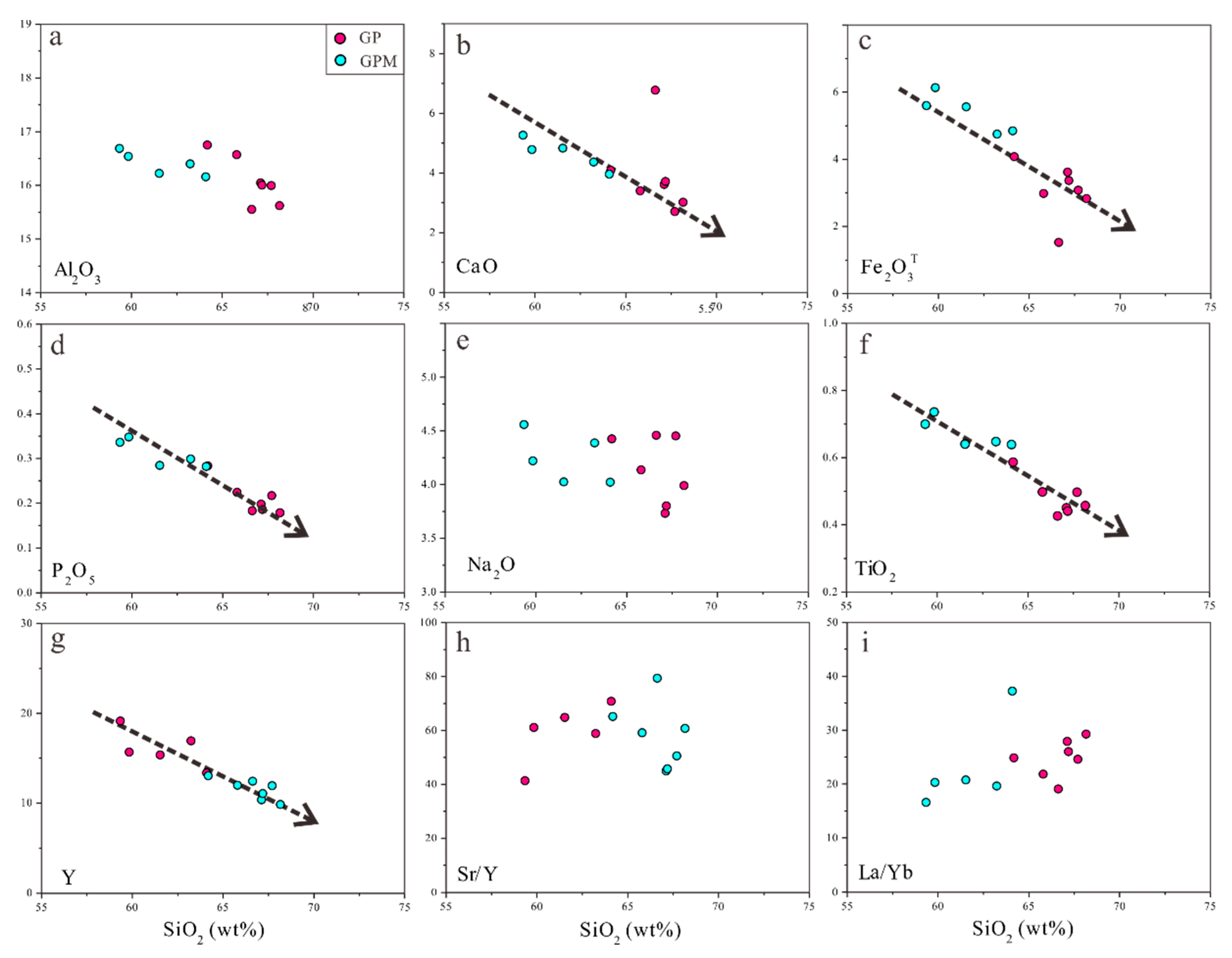

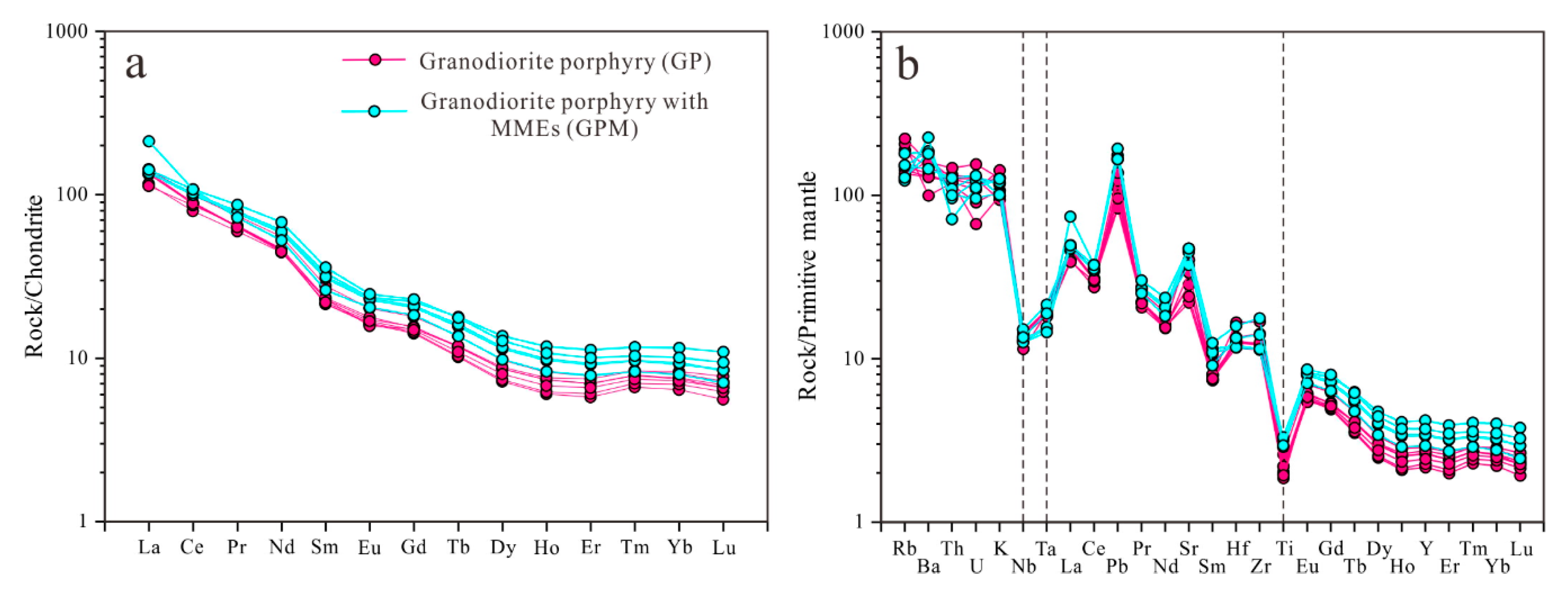
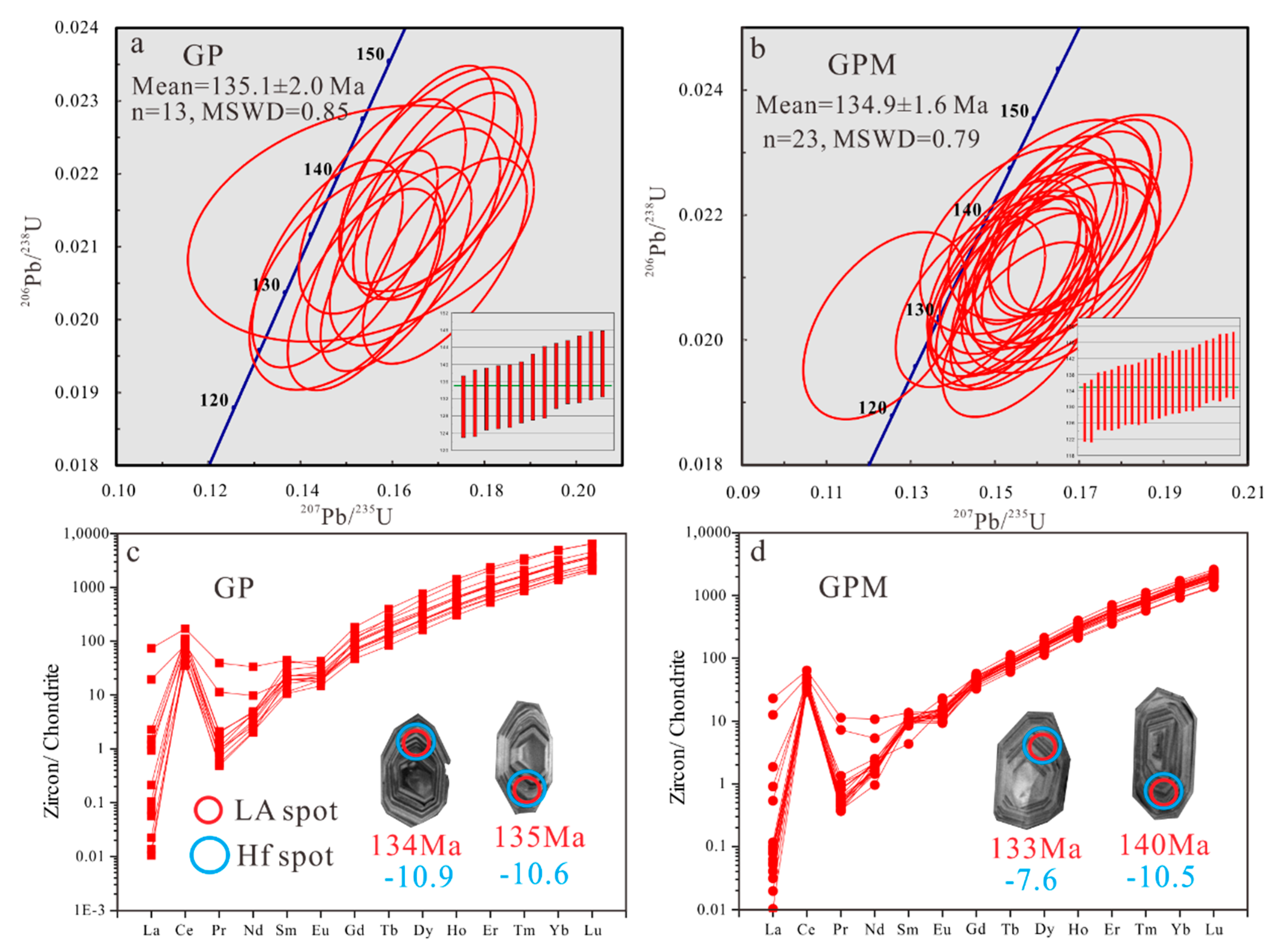

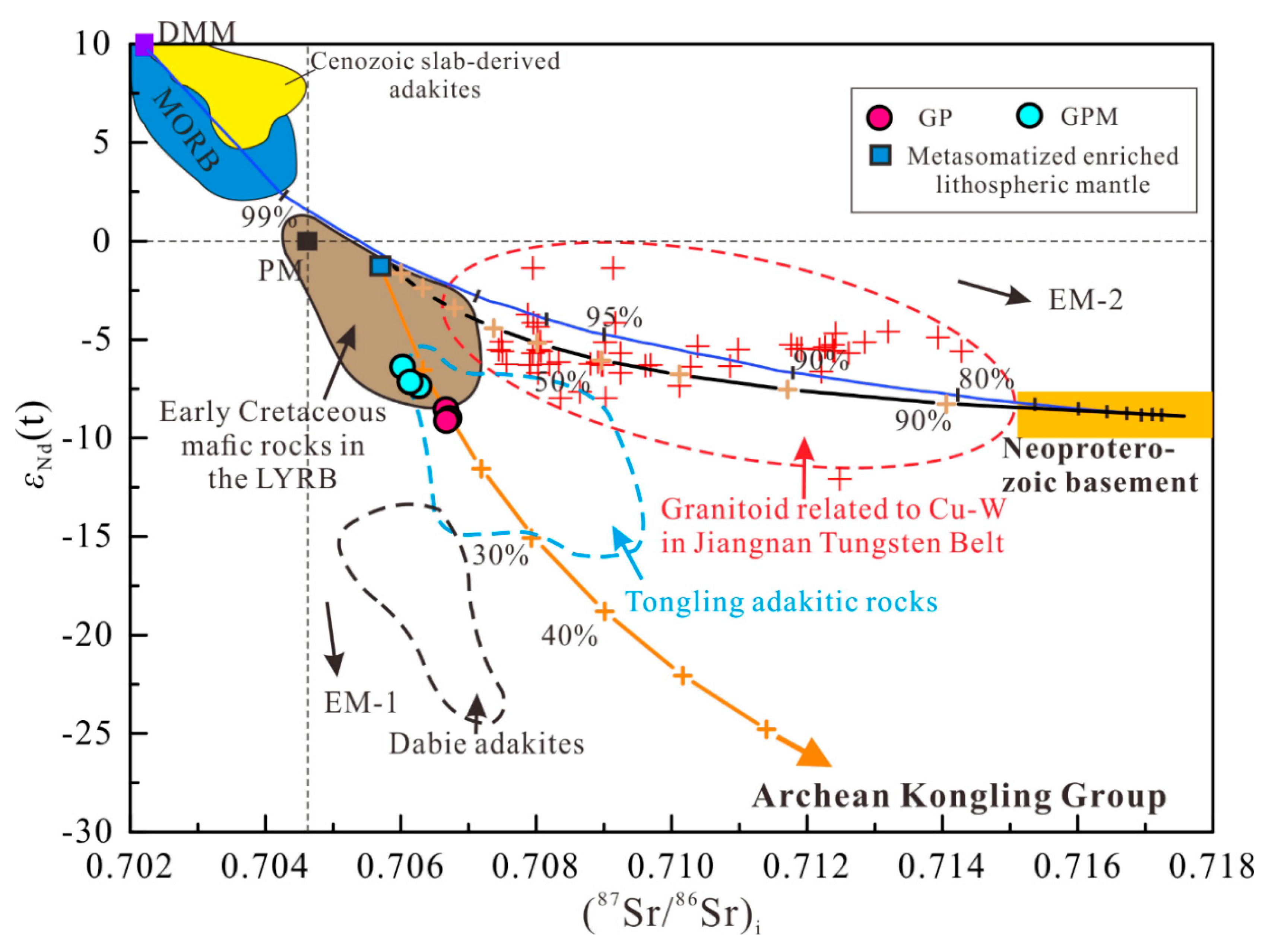
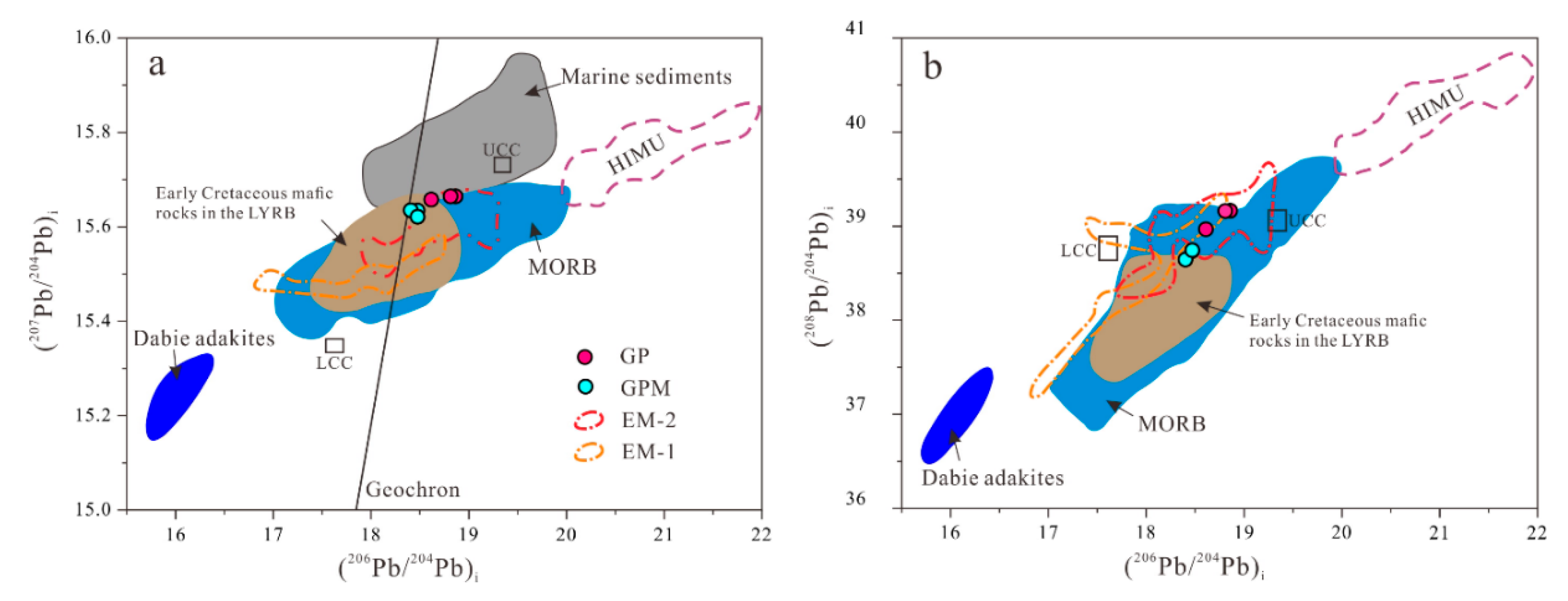


© 2020 by the authors. Licensee MDPI, Basel, Switzerland. This article is an open access article distributed under the terms and conditions of the Creative Commons Attribution (CC BY) license (http://creativecommons.org/licenses/by/4.0/).
Share and Cite
Qi, H.; Lu, S.; Yang, X.; Deng, J.; Zhou, Y.; Zhao, L.; Li, J.; Lee, I. The Role of Magma Mixing in Generating Granodioritic Intrusions Related to Cu–W Mineralization: A Case Study from Qiaomaishan Deposit, Eastern China. Minerals 2020, 10, 171. https://doi.org/10.3390/min10020171
Qi H, Lu S, Yang X, Deng J, Zhou Y, Zhao L, Li J, Lee I. The Role of Magma Mixing in Generating Granodioritic Intrusions Related to Cu–W Mineralization: A Case Study from Qiaomaishan Deposit, Eastern China. Minerals. 2020; 10(2):171. https://doi.org/10.3390/min10020171
Chicago/Turabian StyleQi, Huasheng, Sanming Lu, Xiaoyong Yang, Jianghong Deng, Yuzhang Zhou, Lili Zhao, Jianshe Li, and Insung Lee. 2020. "The Role of Magma Mixing in Generating Granodioritic Intrusions Related to Cu–W Mineralization: A Case Study from Qiaomaishan Deposit, Eastern China" Minerals 10, no. 2: 171. https://doi.org/10.3390/min10020171





